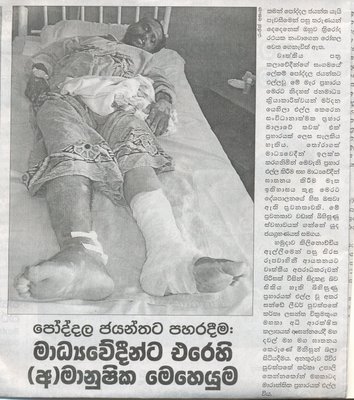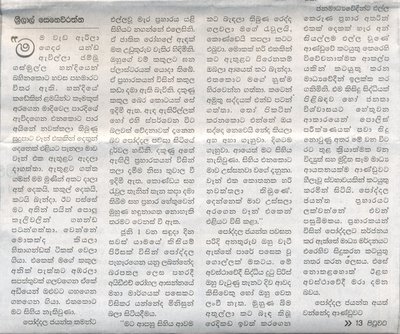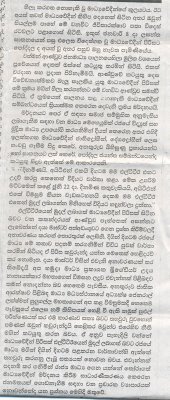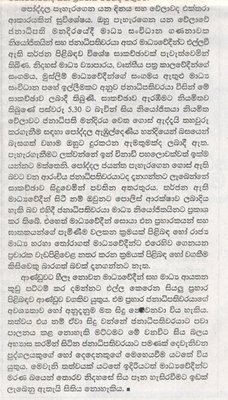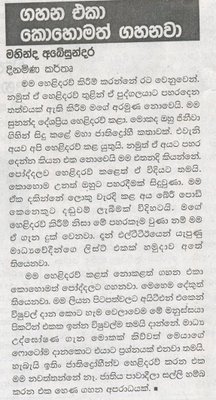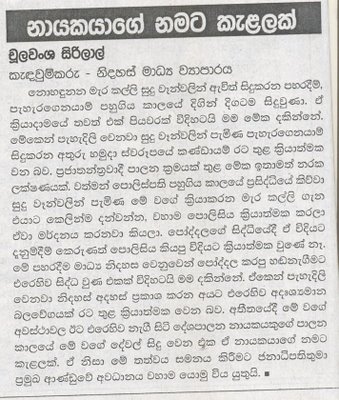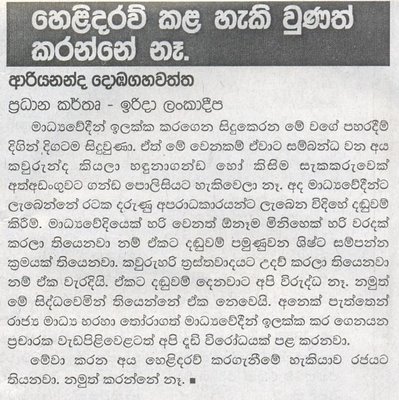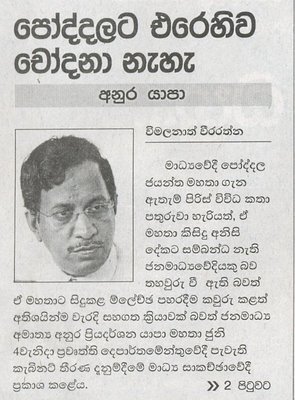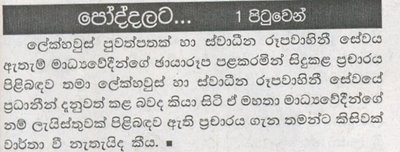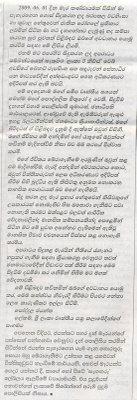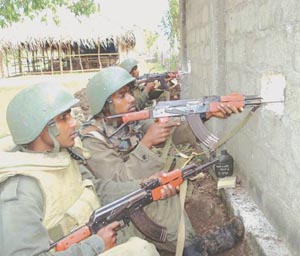by D.B.S. Jeyaraj
The witch hunt against journalists depicted as enemies of the State continues unabated in Sri Lanka.
The latest victim in this “officially sanctioned unofficial campaign” is Poddala Jayantha, a senior Journalist and prominent media rights activist.

[Poddala Jayantha was always at the forefront]
Jayantha, a senior journalist at “Dinamina” the Sinhala daily run by Lake House , is also the General Secretary of Sri Lanka Working Journalists Association (SLWJA) and a key activist of the Free media movement (FMM) in Sri Lanka.
The bearded Jayantha was abducted on June 1st at about 4.30 pm in broad daylight near the Embuldeniya junction in Nugegoda.
WHITE VAN
Jayantha was walking out of a pharmacy when a group of six men manhandled him and swiftly bundled him into a white Toyota Ace van.
Several people witnessed the shocking incident . Among them was someone who knew Jayantha personally.
This person who also knew veteran journalist Bennet Rupasinghe, telephoned him and told him of the incident.
66 Year old Rupasinghe was formerly with the Communist party newspaper “Atha”. Currently he works as news editor of the Lanka e-news web newspaper.
Rupasinghe then told his editor in chief and publisher Sanduruwan Senadheera about the incident. Senadheera and Rupasinghe then began telephoning people to alert them of the abduction.
Since they feared for Jayantha’s life both telephoned as many people as they could about the incident including different media personnel. The intention was to mount pressure on those responsible for ordering the abduction and make them release Poddala Jayantha safely.
COMPLAINT
Rupasinghe had first telephoned the Inspector-General of Police Jayantha Wickremaratne and told him of the incident.
Bennet also informed Jayantha’s wife and advised her to rush to the Police station and make a formal complaint.
She went with a lawyer cum journalist KW Janaranjana and another journalist Jayasiri Jayasekera to the Mirihana Police station and lodged a complaint.
In her complaint she stated that Bennet Rupasinghe had informed her of the abduction.
Meanwhile a badly battered Poddala Jayantha was dumped into a muddy pit by the roadside near the IDH hospital.
An injured Jayantha kept shouting for help saying he was a married man with a child.
But the culture of fear that prevails in Sri Lanka prevented anyone from coming to his help.

[At the hospital]
HOSPITAL
A bleeding Jayantha with blood and mud on his rumpled , torn clothes hobbled on the road for a while and finally hailed a three-wheeler to go to the hospital.
He was warded at the Intensive care unit at National Hospital, Borella.
After surgery he was transferred to a paying ward at the hospital.
The abductors had blindfolded and beaten Jayantha with iron rods and wooden poles accusing him of being a traitor to the country.
At one point the abductors had crushed three of his fingers with a wooden block saying he would not be allowed to write with his hand again.
He had fainted at one stage.
His leg and ankle were broken. In addition he suffered many injuries to face,head, arms, legs and chest.
In a further bid to humiliate Jayantha the cowardly abductors had shaved off parts of his beard and some of the hair on his head.
The white van cowards had forced the hair down Jayantha’s throat making him swallow it.
MEETING
At about the same time that Poddala Jayantha was being abducted and assaulted a delegation of Journalist association representatives was having discussions with President Mahinda Rajapakse on problems faced by the media.
The meeting had been arranged by FMM convenor Chulwansa Sri Lal.
Poddala Jayantha had refused to meet with the President as part of the delegation it was pointless.
Prasanna Fonseka of the SLWJA had attended the meeting instead of Jayantha.
Among others present at the discussion were “Ravaya” editor Victor Ivan and senior journalist Waruna Karunatilleke.
The meeting was held to discuss the safety of journalists in Sri Lanka. There was concern about the campaign to malign some journalists on state media as being paid agents of the LTTE.
While discussions were on, news of the abduction was conveyed to Transport minister Dulles Alahapperuma .
When Alahapperuma informed President Rajapakse of the incident a nonchalant Rajapakse responded that he did not want to get involved in friction between media institutions.
The cryptic comment about alleged “media institution friction” by the President assumed greater significance due to subsequent developments.
In a bizarre twist the Mirihana Police instead of searching for the White van abductors went in search of veteran journalist Bennet Rupasinghe.
INTERROGATION
Rupasinghe was arrested at 8 .pm on June 1st and detained at the Police station for 18 hours till 2.pm on June 2nd.
He was interrogated for hours about alleged discrepancies between his version of the abduction and the complaint made by Mr. Jayantha’s spouse.
Bennet Rupasinghe said during interrogation that he had been informing people of the incident with the approval of Mr. Senadheera.
The Police then telephoned Sandaruwan Senadheera the editor-in-chief and publisher of Lanka e-news and asked him to come to the Police station.
When Senadheera arrived there on June 2nd, his statement was also recorded.
Both journalists were produced before the Nugegoda chief magistrate Vasantha Jinadasa by the Police special investigation unit.
SUSPECTS
Police informed the magistrate that both journalists were key suspects in the case as they had been the first to inform Poddala Jayantha’s wife of the incident.
Lawyers Vidura P. Manchanayake and Manjula Pathiraja who appeared for the two journalists submitted that the journalists had had nothing to do with the incident but upon , hearing of the abduction of Poddala Jayantha, informed his wife and advised her to lodge a complaint with the Police.
Police also said that Rupasinghe and Senadheera had informed the IGP Jayantha Wickremaratne, Media minister Lakshman Yapa Abeywardena, the Director of Information Anusha Pelpita and Presidential adviser on Public Affairs Kumarasiri Hettige about the incident.
As such the Police wanted both Journalists to be remanded pending further investigations.
But the chief magistrate who put off the case for August 3rd declined to remand both.
They were released on personal bail of Rs. 500,000 each and ordered to report to Police every Sunday.
Several media rights organizations and human rights institutions have condemned the abduction and attack.
In order to understand the background to the abduction and attack on Poddala Jayantha a brief excursion into recent events is necessary.
MEDIA RIGHTS
The bearded Poddala Jayantha was a popular figure among journalists as an ardent campaigner for media rights.
He was at the forefront of media demonstrations and also issued several statements critical of the Government despite being a Lake House employee.
According to journalists at Lake House both Jayantha and Sanath Balasuriya the president of Sri Lanka Working Journalists Association (SLWJA) were journalists holding left of centre views.
Both had supported Mahinda Rajapakse during Presidential elections of Nov 2005 and had even campaigned for him.
However as office-bearers of SLWJA both had been later critical of the government for trying to curb and suppress the media.
Despite working at the Government controlled Associated Newspapers of Ceylon Ltd (Lake House) both had courageously stood up for the rights of media personnel regardless of irritation caused to the powers that be.
In association with other media rights organizations the SLWJA had been staging demonstrations and building up public awareness of media suppression
They had issued statements critical of the govt whenever the situation warranted it
When journalists were abducted, arrested or attacked Sanath and Jayantha had rushed to their defence in whatever capacity possible
They attended courts when journalists were charged.
RUPAVAHINI
When the gangster-Parliamentarian Mervyn Silva and heroin dealer “Kudu” Lal had invaded “Rupavahini” premises the employees there had erupted and held both as captives’
Both Sanath and Jayantha had rushed to State TV premises and persuaded employees to release Mervyn and “Kudu”.
Thereafter a number of Rupavahini employees were attacked with knives and razor blades on different occasions by Mervyn’s goondas.None were arrested.
In early January 2008 a gang of thugs in a white van went to the Boralesgamuwa area where Jayantha with the intention of abducting him
But alert residents had protested vehemently compelling the white van cowards to retreat ignominiously. Later villagers held a Bodhi pooja to invoke blessings and protection for Poddala Jayantha (Poddala is the name of his village)
Thereafter a safe houses for both Sanath and Jayantha were set up.
KEITH NOYAHR
On May 22nd 2008 Keith Noyahr , Associate editor and defence columnist of “The Nation” newspaper was abducted by men in civilian clothing. He was assaulted and tortured at a secret location
Prompt action spearheaded by Krishantha Cooray the former Chief Executive Officer of “Rivira media corp” compelled the abductors to release a severely injured Noyahr with a warning that he should stop writing for ever.
Cooray who used his wide-ranging contacts to launch a world-wide agitation for the release of Noyahr was himself under threat later and was forced to relocate to a foreign country.
In the aftermath of the Keith Noyahr incident five media rights organizations held a public demonstration on May 23rd 2008, condemning it and demanding govt action to bring the abductors to justice.
They were Sri Lanka Working Journalists Association (SLWJA), Federation of media employees trade union (FMETU) Sri Lanka Muslim Media Forum (SLMMF),Sri Lanka Tamil Journalists Alliance (SLTJA) and the Free Media Movement (FMM).
It was well known then that FMM convenor Sunanda Deshapriya, and SLWJA stalwarts Sanath Balasuriya and Poddala Jayantha were the livewires behind the protest demonstration.
GOTABHAYA
Shortly after this demonstration Defence secretary and Presidential sibling Gotabhaya Rajapakse summoned Balasuriya and Jayantha to his office. Also present were former “Lakbima” editor and present chairman of Lake House Bandula Padmakumara and Media center for National security director Lakshman Hulugalle.
Secretary Rajapakse went on a tirade against both saying that as Lake House employees they could not go against the Govt. Gota also charged that they were working against the Army commander Sarath Fonseka and the Army. There was a heated exchange of views.
At one point the Journalists said “Just because a war is being waged, if some wrongs are being committed by the military under that guise, it has to be exposed. There is no need to hide behind the guise of war”.
The Defence Secretary retorted “Don’t you understand what I am trying to say? If you don’t agree and continue with what you are doing, what has to happen to you will happen. Laws will be introduced to restrict reporting on the conduct of military or on Commanders of the Armed Forces. The military will campaign for such laws. We can see whether the voice of the military is stronger than the campaign of the journalists.
The Journalists then said “You are making a serious threat on our lives”.
The Defence Secretary replied “No, No. I am not doing it. I am definitely not threatening your lives. I am not. It will happen from where it happens. Our services are appreciated by 99 per cent of the people. They love the Army Commander (Lt. Gen. Fonseka) and the Army. Those who love us do what is required. We cannot help that.”
LETTER
Angered by the Defence secretary’s attempt to intimidate the Lake House Journalists in the presence of their boss, Padmakumara, the five media organizations that organized the Noyahr incident demonstration sent a joint protest letter to Lt. Col (Retired). Gotabhaya Rajapakse.
The letter stated:
“We are extremely disappointed and very concerned to discover that you summoned and reprimanded Sanath Balasooriya and Poddala Jayantha, President and General Secretary of Sri Lanka Working Journalists Association ( SLWJA), over the protest campaign organized by our five media organizations against the abduction and inhuman assault on The Nation journalist Keith Noyahr.”
Your action has no precedent.
“We held this protest campaign peacefully and under the freedom of expression enshrined in our Constitution. The aim of our protest was to demand that the government initiates an open and impartial investigation into the abduction and assault of Keith Noyahr and bring the culprits to book. We openly stated that if the government does not apprehend the culprits and attempts to impair and impede the investigation, we hold it responsible for this heinous crime.
The Letter went on to say:
“We are outraged by your thinly veiled repeatedly expressed threat that the lives of Sanath Balasooriya and Poddala Jayantha would be in grave danger should they continue to defend the right to independent reportage critical of the military and the regime. Clearly, it is a problem that you see no problem in such odious expression. At a time when the President and his government seek to assure us that all is well with the protection and fullest enjoyment of fundamental rights in Sri Lanka, your behavior-and not for the first time-is a significant marker of the ground reality and the challenges facing free media and human rights.
KEHELIYA
Subsequently the issue was raised by journalists at the defence matters press briefing held by Cabinet minister Keheliya Rambukwella.
MCNS director Hulugalle also present was asked specifically about the incident.
He denied that Gotabhaya Rajapakse had threatened the journalists and had only sought a clarification. Hulugalle maintained that as lake House employees both had no right to engage in anti-govt activity.
When asked whether journalists had no rights to engage in politics if they wanted Rambukwella replied as govt employees of Lake house they had no right.
Asked as to why this was not emphasized when Sanath and Jayantha campaigned for Mahinda during Presidential polls Minister Keheliya came out with a characteristic “vihiluwa” “They were summoned to be thanked for that”.
The next major development in this saga was the cowardly assassination of “Sunday Leader” editor Lasantha Wickrematunge on Jan 8th 2009.
RETURN
When threats against journalists increased in the aftermath of the brutal slaying a large number of journalists left the Country., Poddala Jayantha had also been one of the scribes who fled abroad for safety.
He returned to Sri Lanka only a few weeks ago and was living in Nugegoda temporarily. Poddala Jayantha was the first of those who fled abroad in January this year to return to Sri Lanka
This return was seen as an act of defiance. The cowardly bullies are happy when people flee for safety.
Recent events clearly indicate that Poddala Jayantha was singled out to the latest victim of a state sponsored witch hunt to target independent journalists refusing to bow down before this regime .
They were accused of being agents of the Liberation Tigers of Tamil Eelam (LTTE)
Initially Army commander Sarath Fonseka alleged that evidence had been unearthed against Sinhala journalists helping the LTTE. He even said that media rights demonstrations at Lipton’s circus roundabout were bankrolled by the tigers.
This was followed by a media interview of IGP Jayantha Wickremaratne who reiterated the Army commander’s accusation.
VILIFICATION
The Inspector General of police accused unnamed journalists of obtaining money from the LTTE under the guise of campaigning for media freedom in Sri Lanka.
State controlled TV net work ITN showed visuals of Poddala Jayantha on its segment called “After News” while the accusation was being aired.
The bearded Poddala Jayantha’s image flashed across TV screens as references to treacherous journalists getting money from the LTTE were made.
On 22nd May an editorial of the state controlled Sinhala language daily “Dinamina” called for stoning and expelling of so called professional journalists who grow beards and take money from tigers.
Since Poddala Jayantha is well-known known for his beard, there was no doubt about the intended target. It was indeed sadly illustrative of the prevailing media situation that the paper for which Poddala Jayantha worked for more than 15 years should denigrate him this way.
As a result of this vilification campaign , Poddala Jayantha’s little daughter was humiliated at school. She refused to attend school .
The past few weeks saw continued attacks on “unnamed journalists” who had campaigned for media freedom and justice for abducted and killed journalists in Sri Lanka.
TRAITORS
Media ministers Anura Priyadarshana Yapa and Lakshman Yapa Abeywardena added to the confusion by stating different points of view at press conferences about the so called list of media practitioners who got hand-outs from the LTTE.
They were called traitors by various politicians and pro state and state controlled media.
Even the independent “Divaina” newspaper wrote an editorial calling for the death penalty to be imposed on Sinhala journalists who betrayed the Country by taking money from the LTTE
The scene therefore was being set for the abduction and assault of Poddala Jayantha.
SCAPEGOATS
The “officially sanctioned unofficial” incident displayed a new twist by the fact that the two journalists who informed the family and authorities of the abduction were arrested and produced in courts.
This is seen as a crude attempt to prevent journalists from helping fellow journalists in distress and taking appropriate action.
Had it not been for Rupasinghe and Senadheera the fate of Jayantha may have been different.
But now the “good Samaritans” were being penalised. People were being encouraged to be like the Pharisee and Levite in Jesus Christ’s parable
President Rajapakse’s cryptic observation that he did not want to get involved in friction between media institutions followed by Police attempts to charge Rupasinghe and Senadheera of being suspects, strengthens suspicion that some “media sections” are going to be made the scapegoats.
Just as the passer-by who “misappropriated” Lasantha Wickrematunge’s cellular phone has been made prime suspect for the assassination and Kotte municipal councillors have been framed for the attack on MTV/Sirasa, Bennet and Sanduruwan could be made the ” guilty party” for the Jayantha abduction.
The new campaign to malign journalists as paid agents of the LTTE and the abduction of Poddala Jayantha shows that the Government riding the crest of a victory wave is all out to suppress media dissent by targeting potential dissenters with trumped-up charges of tiger links.
DAYA MASTER
The three medical doctors who rendered yeoman service to innumerable people in Mullaitheevu are being detained and interrogated. Attempts are made to elicit the names of journalists who contacted them
LTTE political wing member “Daya master” who surrendered to the Army some weeks ago was interrogated intensely. Thereafter a list of journalist names were compiled on the basis of information allegedly divulged by Daya master.
The so called list of journalists allegedly in the pay of tigers has its genesis in the detention and interrogation of Daya Master. It appears that journalists disliked by the state will be “named” on this list and dealt out punishment as seen fit.
The Poddala Jayantha episode is the first in this phase of this officially sanctioned unofficial campaign. It certainly wont be the last until and unless remedia measures are enacted.
From Prabhakaran to Poddala, the people responsible for helping Mahinda Rajapakse become president are feeling the power of his presidency.Frankenstein dies a thousand deaths as their monstrous creation runs amok
Perhaps the editors and publishers invited for dinner by the President on June 5th will know what lies in store for courageous members of the fourth estate.
The attack on a prominent media rights activist like Poddala Jayantha is very likely to enhance the climate of fear among Sri Lankan journalists and media activists further. -dbsj
I can be reached onEmail: dbsjeyaraj@yahoo.com
Filed under: Good Articals | Tagged: D.B.S. Jeyaraj, FMM, freedom, Human Rights, Human Rights Watch, Hunt, Mahinda Rajapakse, media, media rights activist, Poddala Jayantha, Senior journalist, SLWJA, war | Leave a comment »




